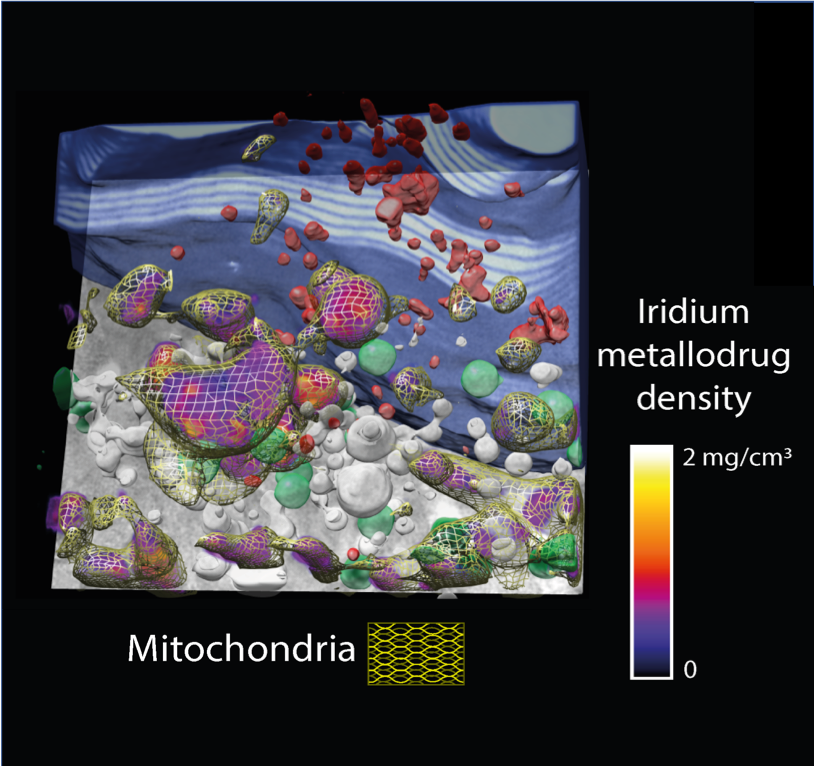Iridium-based metallodrugs are emerging as novel tools to destroy cancer cells by disrupting their intracellular redox balance. Scientists at IMDEA Nanociencia and researchers at ALBA, ESRF and CNB-CSIC have joined efforts to image the anticancer agent at work in the cryopreserved intracellular nano-space.
Chemotherapeutics are key players in the clinical setting to fight most types of cancer, and novel chemicals hold the promise to facilitate new and unique intracellular interactions that modulate the cell machinery and destroy the tumour cells. Equally necessary are new tools that enable the unequivocal location and quantification of such molecules in the intracellular nano-space, so that their therapeutic action is fully understood.
Pizarro’s research team at IMDEA Nanociencia has developed a new family of organo-iridium drug candidates about a hundred times more potent than the clinically used drug cisplatin. Importantly, in collaboration with researchers at the ALBA and ESRF synchrotrons, and at the National Centre for Biotechnology, they have discovered that the mechanism of therapeutic action of this family of iridium-based anticancer agents appears to be radically different to that of cisplatin’s, which is crucial to circumvent drug resistance.
Dr Ana Pizarro explains: “We have been able to observe – using highly advanced synchrotron cryo-techniques – our extremely potent iridium drug candidate in cryopreserved breast cancer cells with nanoscale resolution. This means that we have been able to unambiguously locate iridium in the cancer cell mitochondria and, most strikingly, nowhere else”. It is important that the drug has been exclusively located in the mitochondria as this can help minimise off-target interactions, which usually lead to the undesirable side effects that chemotherapy triggers in cancer patients.
Dr Javier Conesa, key investigator in this project working at MISTRAL beamline in the ALBA synchrotron facilities at the time this research was carried out, and who recently joined the National Centre for Biotechnology, adds: “we have also been able to quantify the iridium drug specifically inside the mitochondria, which is also very important and unique, and not possible when tagging with fluorophores or with bulk experiments. Also it is important to notice that the detection was performed using whole cells, without any sectioning, and that allows to resolve the whole cell context, and in cryo conditions which means that the cell structure and chemical composition is closely preserved to the native conditions. This new developed 3D correlative technology can also be applied to other biological problems and hence we expect to study the distribution of other interesting elements”.
Pizarro adds: “These compounds have the potential of being extremely effective against cancer, yet unless we fully understand their complete journey within the tumour cell, they don’t stand a chance to enter the drug development pipeline. Not only will this understanding help advance truly novel chemotherapeutics in the clinic, it will provide innovative tools to intervene processes related to cancer progression. It is a long road and this work represents the first step”. The work Pizarro refers to has recently been published in the journal Angewandte Chemie International Edition.
Dr Ana Pizarro is a research scientist at IMDEA Nanociencia. After a decade of research work in the UK in the universities of Edinburgh and Warwick she joined IMDEA Nanociencia with a Ramón y Cajal Fellowship to study how metal-based compounds can modulate the cancer cell machinery. She got tenure in 2019.
Dr Javier Conesa, after a postdoc at ALBA synchrotron, joined the National Centre of Biotechnology to implement a cryocorrelative microscopy platform. Education: Ashland University Biology
This work is a joint effort of Pizarro’s laboratory (AMP, ACC, VRF; IMDEA Nanociencia), experts working in the synchrotron facilities in cryo soft X-ray tomography (JJC, EP, MISTRAL beamline ALBA) and cryo hard X-ray fluorescence (YY, PC, ID16A beamline ESRF), and the National Centre of Biotechnology (JLC, CNB-CSIC). IMDEA Nanociencia and CNB-CSIC are both Severo Ochoa Centres of Excellence. This work has been supported by funding of a number of National and International agencies such as the Spanish Ministry of Economy and Competitiveness, EC-FP7, ALBA and ESRF.
Contact
Dr Ana Pizarro
IMDEA Nanociencia Outreach Office
divulgacion.nanociencia@imdea.org
+34 912998712
Twitter: @imdea_nano
Facebook: @imdeananociencia
Source: IMDEA Nanociencia
